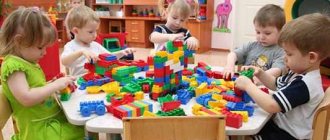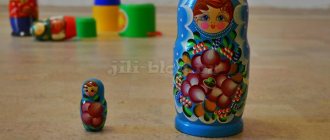Planning a theater week. methodological development (senior group) on the topic
Children's whole life is filled with play. Every child wants to play their role. Teaching a child to play, take on a role and act, while at the same time helping him gain life experience - theater helps to achieve all this.
Theater is a means of emotional and aesthetic education of children in kindergarten. Theatrical activities make it possible to develop the experience of social behavioral skills due to the fact that every fairy tale or literary work for preschool children always has a moral orientation (kindness, courage, friendship, etc.). Thanks to the theater, a child learns about the world not only with his mind, but also with his heart and expresses his own attitude towards good and evil. Theatrical activities help the child overcome timidity, self-doubt, and shyness. Theater in kindergarten will teach the child to see the beautiful in life and in people, and will give rise to the desire to bring the beautiful and good into life. Thus, theater helps the child develop comprehensively.
Goal: Development of children's creative abilities through theatrical art.
Objectives: 1. Create conditions for the development of creative activity of children participating in theatrical activities. 2. Improve children’s artistic skills in terms of experiencing and embodying the image, as well as their performing skills. 3. Teach children the elements of artistic and figurative means of expression (intonation, facial expressions, pantomime). 4. Activate children’s vocabulary, improve the sound culture of speech, intonation structure, and dialogic speech. 5. To develop experience in social behavior skills and create conditions for the development of children’s creative activity. 6. Introduce children to various types of theater (puppet, musical, children's, animal theater, etc.). 7. To develop children's interest in theatrical play activities.
Planning a theater week in the senior group “Rybka”.
| Days of the week: | Morning time slot: | GCD: | Evening time period: |
| Monday 21 March | -Morning exercises. — Introduction to the concept of theater: (showing slides, paintings, photographs). Types of theaters (musical, puppet, dramatic, animal theater, etc.). Purpose: to give children an idea of the theater; expand knowledge of theater as an art form; introduce types of theaters; cultivate an emotionally positive attitude towards the theater. — Opening of the theater week: the production of “The Three Little Pigs” performed by teachers. | Artistic and aesthetic development: modeling “Favorite fairy-tale hero”. Goal: Learn to convey the image of your favorite character; develop creative abilities. Musical lesson: learning a song about numbers. | — Plot-role-playing game “We came to the theater.” Purpose: to introduce the rules of behavior in the theater; arouse interest and desire to play (play the roles of “cashier”, “ticketer”, “spectator”); cultivate friendly relationships. — Conversations about the rules of behavior in the theater, give the concept of the proverb “Audience culture.” Goal: To give children an idea of the rules of behavior in public places; to form a personal attitude towards non-compliance and violation of rules. — Screening of a video recording of the puppet show “Visiting Grandma.” Goal: to introduce children to one of the types of theater - puppet theater. Working with parents: designing an information stand (moving folder) “Theater and Children.” Conversations with parents on the topic of the week. |
| Tuesday March 22 | -Morning exercises. — Introducing children to finger theater. Goal: to give children an idea about the features of this type of theater. — Finger gymnastics. “Bird”, “Owl” and others. Goal: speech development, development of intelligence, spatial thinking, creative abilities of children. — Game “Create a funny and sad dialogue between the Mouse and the Bunny.” Goal: Develop communication skills; diversify intonation expressiveness; pay special attention to children's diction. — Theatrical production “The Little Goat Who Could Count to 10” performed by children. Goal: introducing children to theatrical art. | REMP: “The pattern of arrangement of objects. Comparison of objects by size." Goal: to learn to compare objects by size without putting them next to each other; consolidate the ability to arrange objects in a given order. Artistic and aesthetic development: collective application “There is a tower in a field.” Goal: to improve children’s ability to cut circles from squares of different sizes, develop fine motor skills of their fingers, and develop creativity; compose a composition; supplement with various elements. | — Children's games with sounding instruments. Goal: to give children an idea of the musical design of performances. — An evening of riddles based on the works “The Tale of the Fisherman and the Fish”, “Little Red Riding Hood”, “The Tsokotukha Fly”, “Fedorino’s Mountain”, “Kolobok”, “Teremok”, “Turnip”. — Game “Try it yourself.” Finger theater (at the teacher's choice). Goal: to develop children’s ability to use finger theater in free activities; distribute characters; convey the characteristic features of the heroes of the fairy tale. — S/r game “A trip to the puppet theater.” Purpose: To acquaint children with the structure of the theater building, to draw attention to the originality of the architecture and the beautiful facade. Enrich children's vocabulary. Working with parents: making posters for the play “The Little Goat Who Could Count to 10.” |
| Wednesday March 23 | -Morning exercises. — Acquaintance with types of theaters for children (tabletop, bibabo puppet theater, puppets). Goal: to introduce children to different types of theaters; deepen interest in theatrical games; enrich your vocabulary. — Looking at bi-ba-bo dolls with children. A conversation about how to properly use dolls, which is a tool for driving bi-ba-bo dolls. - Reading the Russian folk tale “Zayushkina’s Hut”, conversation on the content. - Showing the fairy tale “Zayushkina’s Hut” using bi-ba-bo toys by the teacher. After the show, invite the children to try to play out the heroes of the fairy tale on their own using bi-ba-bo toys. Goal: introducing children to theatrical art. | Speech development: “Dolls-toys and dolls-artists” (conversation with children according to the teacher’s plan). Goal: Encourage children to compose simple stories with characters from familiar works. Cultivate a sense of humor and help improve children's self-esteem. Develop children's coherent speech. Musical lesson: | - Visiting gr. "Christmas tree." Theatrical puppet show "Little Red Riding Hood". Goal: To develop children's interest in puppet theater. — Psycho-gymnastics “Different faces”. Goal: Encourage children to experiment with their appearance (facial expressions, gestures). Develop children's ability to switch from one image to another. — Independent activity of children in the theater corner. Sketches with tabletop dolls based on well-known Russian folk tales. Goal: Improve puppeteering techniques, consolidate knowledge about the rules for manipulating theatrical puppets of different systems. Working with parents: consultation for parents: “So that the fairy tale does not become boring...”. Recommendations for parents on choosing fiction for children. |
| Thursday March 24 | -Morning exercises. — Exercise “Tell the poems of A. Barto using gestures and facial expressions.” Goal: Learn to convey the images of characters using expressive plastic movements. Develop creativity, imagination and imagination. — Psycho-gymnastics. Goal: Learn to use intonations, pronouncing phrases sad, happy, angry, surprised. Learn to build dialogues by choosing your own partner. “Sad and cheerful puppy” (based on the fairy tale by N. Suteev “Who said meow?”); — Games “We won’t say what we did.” Goal: To develop resourcefulness, imagination, fantasy. Cultivate goodwill. Prepare children for actions with imaginary objects. | The child and the world around him: “Theater professions.” Goal: to clarify children’s knowledge about theatrical professions (director, make-up artist, costume designer, prompter, actor, cameraman, stagehand, etc.); consolidate labor skills. Develop children's communication abilities, creative thinking, imagination. Physical education activity: Artistic and aesthetic development: | — Work on the album “All about the theater.” Goal: To teach children to generalize their experience and share their impressions of new knowledge. Develop aesthetic taste in album design (joint work of children and parents). -S/r game “We are artists” (production of a fairy tale well known to children). Purpose: To acquaint children with the scenario (direction) of a fairy tale. Teach children to express their opinion about a fairy tale in a new way. Complete the tale with the necessary episodes. Cultivate the ability to listen to the opinions of others, develop endurance and patience. — Watching a video of a puppet show. Goal: To evoke positive emotions in children. Work with parents: invite parents to get acquainted with the posters of Moscow theaters whose repertoire includes children's performances. |
| Friday March 25 | -Morning exercises. — Psycho-gymnastics. Teach children to guess their emotional states from the expressive performance of fairy-tale characters. — Acquaintance with the folklore of the peoples of the world: “Let’s dance...”, Russian folk songs, nursery rhymes, counting rhymes, riddles: “They sent the young man.” - “Share your impressions of the theater” - conversation with children. | Speech development: fiction. Reading and discussion of V. Suteev’s fairy tale “Who said meow?” Goal: To develop resourcefulness, imagination, fantasy. Cultivate goodwill. Prepare children for actions with imaginary objects. Physical activity: Artistic and aesthetic development: drawing “Favorite fairy-tale hero.” Goal: learn to convey the image of your favorite character in a drawing; use material in the work at the request of the children; develop creative abilities. | — Rhythmoplasty. Sketches for movement: “The Fox is Coming”, “Dance of the Animals”. Goal: To develop children's ability to use gestures. — Voice-over of a fairy tale chosen by children using noise instruments. Encourage children to creatively interpret famous stories using noise instruments. — Musical show - performance in a group with soap bubbles. Goal: create a joyful and cheerful mood; encourage children to become active participants in the performance; learn to convey the impressions received vividly and emotionally. |

